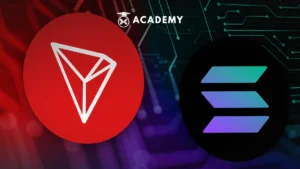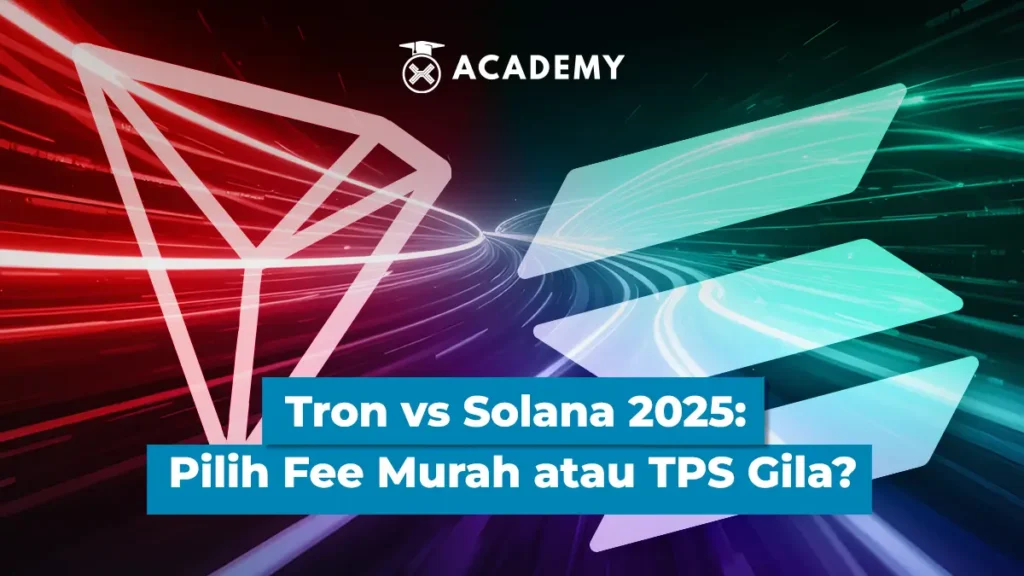Amidst the buzz surrounding DeFi and the crypto world throughout 2025, Tron and Solana have become two of the most talked-about networks. Although they are often compared, the two actually have fundamental differences, both in terms of performance and purpose.
The popularity of Tron and Solana continues to rise, but many new users are still confused about the differences in their main functions.
Through this article, you will find it easier to make a choice: which network is better suited for transactions—one that is cost-effective or one that offers exceptional speed? Here’s a detailed review.
Origins & Philosophy: Different Directions from the Start

To understand the direction of a blockchain’s development, we need to revisit its original purpose. In this regard, Tron and Solana grew from very different visions from the beginning.
Tron was founded by Justin Sun in 2017 with the mission of decentralizing the internet, particularly in digital content distribution.
The goal was to give creators greater power to directly reach audiences without intermediaries. The acquisition of BitTorrent in 2018 strengthened Tron’s position as a content-sharing network.
Tron also equipped its infrastructure with the TRON Virtual Machine (TVM), which is compatible with Ethereum, and is slowly expanding into the DeFi and stablecoin sectors as a fast and low-cost transaction network.
Meanwhile, Solana was born from the idea of Anatoly Yakovenko in the same year, but with a different focus: technical performance. Yakovenko wanted to create a blockchain with thousands of TPS capacity and minimal fees.
By combining Proof of History and Proof of Stake, Solana successfully delivers high scalability and exceptional efficiency.
Officially launched in 2020, Solana immediately attracted projects in DeFi, NFTs, and even Web3 gaming. Innovations like Solana Pay also demonstrate its ambition to expand into the digital payments sector.
This clearly demonstrates that Tron was built for the content revolution, while Solana focuses on Web3 speed and scalability.
Network Technology: DPoS vs. PoH+PoS
While both adopt cutting-edge consensus systems, Tron and Solana develop their networks in very different ways, from their underlying structure and transaction validation mechanisms to their speed performance.
Tron uses Delegated Proof of Stake (DPoS), where only 27 validators (super representatives) are authorized to validate blocks.
This system allows for fast and cost-effective transactions, but it is also often criticized for being too centralized.
However, this model is well-suited for Tron, which focuses on digital entertainment, NFTs, and stablecoin delivery, offering a lightweight and stable experience.
Meanwhile, Solana combines Proof of History (PoH) and Proof of Stake (PoS). PoH allows for precise transaction timekeeping without the need for global synchronization, speeding up validation.
This combination allows Solana to handle tens of thousands of transactions per second with near-zero fees, making it ideal for DeFi, gaming, and large-scale applications.
Solana also continues to innovate with Firedancer, a new validator client developed in partnership with Jump Crypto, designed to improve network stability and scalability.
Transaction Speed: Solana Fast, but Consistent?
In the blockchain world, speed isn’t just about high TPS, but also about maintaining stable performance amidst heavy network activity. This is where Solana and Tron stand out, albeit with different approaches.
Solana has a reputation as one of the fastest networks, with a theoretical capacity of processing up to 65,000 transactions per second.
In practice, Solana is capable of real-time speeds of around 726 TPS and even reaching 7,229 TPS at peak conditions.
With block times of less than 0.5 seconds, Solana is a favorite for Web3 applications that demand instant responses, from gaming to DeFi.
However, despite its speed, Solana still faces stability challenges when the network is overloaded with high traffic. Its technological complexity makes it susceptible to downtime, especially during periods of extreme load spikes.
On the other hand, Tron may not be as high as Solana’s theoretical speed of around 2,516 TPS, but it is known for its exceptional stability.
In real-world conditions, Tron operates at around 66 TPS and remains consistent, even when traffic peaks at 236 TPS. This makes it ideal for uninterrupted transfers of stablecoins, digital content, and light transactions.
In conclusion, Solana excels in raw speed and high scalability, while Tron relies on stability and efficiency to meet daily transaction needs.
Transaction Fees: Tron Still the King of Zero Gas Fees
When it comes to cost efficiency, it’s important to note that Tron remains a favorite among many crypto users.
While Solana is also known for its super-low transaction fees, Tron still excels with its near-zero gas fees, and this isn’t just a claim, but a reality.
Transaction fees on the Solana network are extremely low, averaging only around $0.00025 per transaction.
This is highly efficient, especially considering its high speed and advanced infrastructure. Solana is clearly ideal for high-volume DeFi applications and blockchain games.
However, Tron takes a different approach with its Delegated Proof of Stake system. The result? Transaction fees are virtually negligible. That’s why many platforms, including major exchanges, prefer TRC-20 for sending USDT.
Not only is it cheap, but it’s also stable and reliable for large transfers.
Even among retail and institutional users, TRC-20 is often the preferred choice over ERC-20 or even Solana, especially when wanting to send USDT to a personal wallet or another platform quickly and cost-effectively.
In essence, Solana is efficient, but Tron remains undisputed as the low-cost king in the stablecoin ecosystem.
Ecosystem: DeFi vs Stablecoin

Although both are layer-1 blockchains, Solana and Tron take very different paths when we look deeper into their respective ecosystems.
Solana is rapidly growing as a hub for high-speed DeFi and Web3 innovation. Projects such as Jupiter, Kamino, and MarginFi reflect an active, dynamic, and trader-friendly ecosystem.
Additionally, with NFT marketplaces and GameFi leveraging transaction speeds under one second, Solana is truly designed for large-scale, resource-intensive applications.
With its Proof-of-History architecture, over 1,000 validators, and 5,000,000 daily transactions, Solana is the top choice for real-time applications, complex dApps, and the ever-growing DeFi ecosystem.
On the other hand, Tron takes a simpler yet efficient approach. Its primary focus is on cheap and fast money transfers, particularly through the dominance of USDT based on TRC-20.
Although it has its own DeFi platform like JustLend, Tron’s core strength lies in the efficiency of cross-border stablecoin transfers with near-zero fees and a 3-second block time.
This is why Tron is widely chosen by beginners, exchanges, and crypto wallets as a daily payment solution.
In short, Solana is better suited for those who want to actively dive into the world of DeFi and Web3. Meanwhile, Tron is ideal for fast, cheap, and stable stablecoin transfers.
Security & Centralization: Stable vs. Transparent
Speed and low fees are tempting, but they’re all for naught if the network is insecure or overly centralized. This is the dilemma that arises when comparing Solana and Tron: stability versus decentralization.
Solana is known for its super-fast performance, with a block time of 0.4 seconds and a finality of 12.8 seconds. It’s ideal for applications that demand fast response and high performance.
However, this high performance has caused issues, including several Solana downtimes.
To address this, Solana is now developing Firedancer, a new validator client designed to be more stable and scalable to tens of thousands of TPS.
In terms of decentralization, Solana has over 1,000 validators and a Nakamoto Coefficient of 21—quite high. However, because some major decisions are still made off-chain, its governance is sometimes considered less transparent.
Meanwhile, Tron excels in stability. Since 2018, it has rarely experienced major disruptions. While its block time is 3 seconds and its finality is around 57 seconds, Tron is reliable in terms of consistency, especially for stablecoin transfers.
However, despite this stability, its decentralization is limited. Tron only has 27 validators and a Nakamoto Coefficient of 5. Despite using an on-chain governance system, key decisions remain concentrated in the hands of a few.
If you prioritize decentralization with continuously improving performance, Solana is a better fit. However, if network stability and reliability are top priorities, Tron can offer greater convenience, but carries a higher risk of centralization.
Market Cap, Liquidity, and Market Position
Amidst the fierce competition among Layer 1 blockchains, Solana and Tron have emerged as two major players with their own distinct advantages.
Both offer fast transactions and low fees, but they have built their ecosystems with very different approaches, creating contrasting market images and values.
In terms of market performance, Solana holds a significant lead in terms of capitalization and token price.
According to CoinMarketCap data as of July 28, 2025, the price of SOL was in the range of $189–$190, with a market cap of approximately $102,000,000,000 and a circulating supply of approximately 538,000,000 tokens.
This figure demonstrates strong investor interest in Solana, particularly due to its active ecosystem in the DeFi, NFT, and GameFi sectors. Its Proof of History consensus mechanism is also a major draw for developers.
On the other hand, Tron stands out as an efficient payment network. Although the price of TRX is only around $0.31 with a market cap of $29,300,000,000 and a circulating supply of 94,700,000,000 tokens, Tron dominates stablecoin transaction volume.
This network is the primary platform for TRC-20-based USDT transfers, with a monthly volume exceeding $600,000,000,000. This makes Tron a key infrastructure in the global stablecoin ecosystem.
This difference in focus explains why Solana outperforms in valuation, while Tron remains relevant through its strength in the payments sector.
Solana is developing as an innovative platform for Web 3, while Tron dominates the fast and cheap value transfer sector.
Which One Is Right for You?
Ultimately, the choice between Solana and Tron largely depends on who you are in the crypto world and what your goals are.
If you’re a beginner looking for fast, cheap, and easy transactions, then Tron could be an ideal choice. This blockchain is user-friendly and popular in the digital entertainment world because it supports content creators with low fees.
However, if you’re a developer or DeFi trader who needs high performance, then Solana is a better fit. Its network is very fast, cheap, and more decentralized, ideal for building complex Web3 applications.
So, tailor your choice to your goals, whether simple efficiency with Tron or broader Web3 exploration with Solana.
Conclusion: Tron vs. Solana Don’t Have to Be a Fight
So, that was an interesting discussion about the Tron vs. Solana Comparison 2025: Choose Cheap Gas Fees or Insane TPS, which you can read more about in the crypto academy at INDODAX Academy.
In conclusion, Tron and Solana are not two projects that should be pitted against each other. Instead, both exist to address different needs within the blockchain ecosystem.
Solana excels in speed, innovation, and the diversity of Web3 projects. Meanwhile, Tron stands out for its cost efficiency, network stability, and strong role in stablecoin transfers.
By 2025, both will have their place; it’s not a matter of who is best, but rather who best suits user needs.
By the way, besides broadening your investment horizons, you can also stay updated with the latest crypto news and monitor digital asset price movements directly on the INDODAX Market. For a more personalized trading experience, explore our OTC trading service on INDODAX. Don’t forget to activate notifications to stay up-to-date with the latest information about digital assets, blockchain technology, and various other trading opportunities, only on INDODAX Academy.
You can also follow our latest news through Google News for faster and more reliable access to information. For an easy and secure trading experience, download INDODAX’s best crypto app on the App Store or Google Play Store.
Maximize your crypto assets with the INDODAX Earn feature, a practical way to earn passive income from your savings.

Also follow our social media here: Instagram, X, Youtube & Telegram
FAQ
1.What are the main differences between Tron and Solana?
Tron is designed for transaction efficiency and the dominance of stablecoins like USDT, while Solana is built for high speed and supporting dApps, DeFi, and NFT ecosystems. Their goals are different, and their technologies are also different.
2.Which is faster for transactions: Solana or Tron?
Solana is much faster in terms of TPS, reaching over 65,000 TPS. Tron is slower at around 2,500 TPS, but it is stable and very efficient for small transactions like stablecoin transfers.
3.Which is cheaper for crypto transfers?
Tron (TRC-20) remains the king of cheap transfers—its fees are almost zero. Solana is also very cheap, but still slightly above Tron, at around $0.00025 per transaction.
4.Can you stake on Tron and Solana?
Yes. On Tron, you can stake TRX and vote for Super Representatives to earn rewards. On Solana, you can stake SOL through validators or platforms like Marinade and Lido.
5.Which is better suited for dApps and DeFi?
Solana excels for dApps and DeFi due to its high speed and mature ecosystem. Tron is better suited for simple transfers and loans with low fees.
6.Which is safer, Tron or Solana?
Tron excels in network stability and experiences almost no downtime. Solana has experienced a few downtimes, but has been strengthened with new clients like Firedancer, developed by Jump Crypto.
7.Are Tron and Solana suitable for beginners?
Tron is suitable for beginners who need to send stablecoins at low fees. Solana is better suited for users who want to explore DeFi, NFTs, and other Web3 features.
8,Which will be more popular in 2025?
Solana has a strong market capitalization and Web3 ecosystem. However, Tron remains strong in terms of USDT transaction volume and global adoption in regions like Southeast Asia.
9.Are Solana and Tron in direct competition?
Not entirely. Solana focuses on smart contract performance, while Tron focuses on transfer efficiency and mass adoption. They are more on different paths than competing against each other.
10.Can you buy Tron and Solana on Indodax?
Of course you can! Both are available and actively traded on the Indodax Market. You can buy TRX and SOL with Rupiah instantly and securely.
Author: Boy





 Polkadot 8.92%
Polkadot 8.92%
 BNB 0.50%
BNB 0.50%
 Solana 4.81%
Solana 4.81%
 Ethereum 2.37%
Ethereum 2.37%
 Cardano 1.35%
Cardano 1.35%
 Polygon Ecosystem Token 2.13%
Polygon Ecosystem Token 2.13%
 Tron 2.85%
Tron 2.85%
 Market
Market


